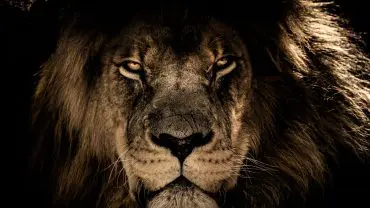Why do lions sleep more than any other African animal? Why do they live in groups and what drives lion pride behaviour? How do lion characteristics influence their lifestyle? From their roar to their cub rearing, every lion action and reaction has a reason and purpose. And researchers have worked tirelessly to uncover the secrets behind each type of lion behaviour.
Choice of Habitat

Out in the wild (Photo: 2630ben via iStock)
Prime habitat for lions is open woodlands, thick grassland, and brush habitat, where there is enough cover for hunting and denning. These areas of grassland habitat also provide food for the herbivores that lions prey upon.
Lion Pride Behaviour

Pride of lions on the hunt together (Photo: Zhanna Muzalevskaia via iStock)
Lions are the only member of the cat family to live in prides. These are groups of about 15 lions, mostly made up of females.
Lion social behavior is often said to have its evolutionary roots in the fact that it is easier to hunt in groups. Not only does it increase the chances of success, but it reduces the chances of injury. Therefore, it balances out the reduced share of food each lion receives.
However, some researchers have found that this is not always the case. They observed that group hunting was only required to prey on larger animals. Females were often seen to hunt smaller creatures, such as warthogs, individually. The rest of the pride would look on.
They attributed the advantages of pride living to other factors such as defence of territory and cubs.
The Lion’s Share of the Work
Lion characteristics are central to the pride’s division of labour. Lionesses do the vast majority of a pride’s hunting, their lighter, smaller bodies making them the faster and nimbler sex. They are also the primary cub rearers. This teamwork creates a wider pool of skills as well as better protection for females and their offspring.
As for the male of the species, they provide protection for their pride. They care for the cubs when the females hunt and defend the ‘pride areas’ or territory. They are amply rewarded for this with more food than the females.
Lion Social Behaviour: It Takes A village

Protective mother and cubs (Photo: dalhethe via iStock)
Lion childcare arrangements are communal. Lionesses tend to give birth at similar times and group together to look after all the cubs of a similar age. These “creches“ last a year or two and allow mother lions to best defend their cubs from male lions and other predators. Lionesses will also nurse other mothers’ cubs.
Territory: Location, Location, Location

African lion male crossing a river (Photo: Utopia_88 via iStock)
Territory is a vital component of a lion’s survival and quality of life. It’s one of the prime reasons they form into prides. A good territory will offer lions proximity to everything they need, specifically shelter, food and water. The latter two tend to be linked. Lions tend to settle near a river because, just like them, their prey will seek out water.
As a general rule, the better the territory, the larger the pride and larger prides can control a wider territory. The male lions mark their territory with a mix of urine and scent from their glands.
Hitting all the Right Notes

A raging roaring lion (Photo: undefined undefined via iStock)
A lion’s roar has a multitude of meanings. Audible from up to five miles away, this thunderous sound is one of the ways in which they defend their territory. Other lions will know how many lions are roaring at once and are less likely to attack if they hear larger groups. But there is also a social aspect to roaring. Lions know the sounds of friends and family as opposed to strangers.
Sleeping

Let sleeping lions be (Photo: Gerrit_de_Vries via iStock)
Rather than sustained activity throughout the course of a day, lions tend to act in short, sharp bursts. The powerful build of these big cats means they get very hot, very fast. As such this sort of sporadic as opposed to prolonged movement allows them to avoid overheating. As does their mostly nocturnal lifestyle.
This is also reflected in their hunting, where they do not seek out prey, but rather lie in wait. This again shows the importance of territory encompassing busy waterholes where other animals are likely to converge.
Given their intense approach to productivity, lions find themselves with plenty of downtime. In fact, they sleep for approximately 20 hours every day.
On Top of the World

Lioness resting high up in a tree (Photo: Jennifer Watson via iStock)
When a lion is looking to escape, say from a herd of vengeful buffalo or swarm of flies, they climb a tree. Lionesses sometimes do this as a way to get some peace and quiet from the demands of their cubs.
Lion Social Behaviour: Not all Fun and Games
Lion social behaviour is learned from an early age through play that mimics the adults around them. Lion cubs are initially timid within the pride, but are naturally playful. A healthy cub is a playful cub and they can turn anything into a toy, whether it be a stick or someone else’s tail.
A Complex Lifestyle

Happy family (Photo: Karan Mota via iStock)
Given they’re asleep for the vast majority of the time, you would think lion behaviour wouldn’t amount to much. But in fact lion social behavior is incredibly complex, adapted to suit both their physiology and surroundings. They are the most social of all the cats, taking advantage of group living to maximise their quality of life.












